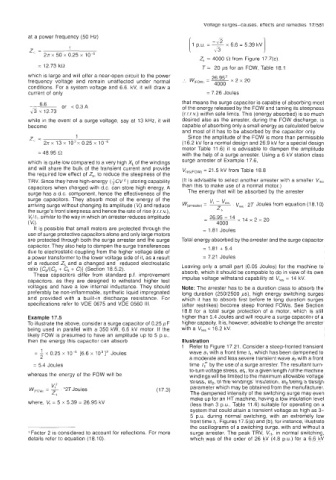Page 616 - Industrial Power Engineering and Applications Handbook
P. 616
Voltage surges-causes, effects and remedies 17/581
at a power frequency (50 Hz) -
42
[ 1 P.U. = x 6.6 = 5.39 kV
z, 1
=
2rrx 50 x 0.25 x 10-6
2, = 4000 Q from Figure 17.7(c).
= 12.73 k0 J = 20 ps for an FOW, Table 18.1
which IS large and will offer a near-open circuit to the power
=
frequency voltage and remain unaffected under normal :. w,,,,, x 2 x 20
conditions. For a system voltage and 6.6. kV, it will draw a
current of only = 7.26 Joules
that means the surge capacitor is capable of absorbing most
or < 0.3A of the energy released by the FOW and taming its steepness
& x 12.73 (r.r.r.v.) within safe limits. This (energy absorbed) is so much
while in the event of a surge voltage, say at 13 kHz, it will desired also as the arrester, during the FOW discharge, is
become capable of absorbing only a small energy as calculated below
and most of it has to be absorbed by the capacitor only.
z, 1 Since the amplitude of the FOW is more than permissible
=
2rrx 13 x 103x 0.25 x lo-‘ (16.2 kV for a normal design and 26.9 kV for a special design
motor Table 11.6) it is advisable to dampen the amplitude
= 48.95 Q with the help of a surge arrester. Using a 6 kV station class
which is quite low compared to a very high X, of the windings surge arrester of Example 17.6,
and will share the bulk of the transient current and provide Vres(FOW)
= 21.5 kV from Table 18.8
the required low effect of Z,, to reduce the steepness of the
TRV. Since they have high-energy ($V’ ) storing capability (It is advisable to select another arrester with a smaller V,,,
capacitors when charged with d.c. can store high energy. A than this to make use of a normal motor.)
surge has a d.c. component, hence the effectiveness of the The energy that will be absorbed by the arrester
surge capacitors. They absorb most of the energy of the - vt - v,,,
arriving surge without changing its amplitude (V,) and reduce W(arrester) - ~ . 2J Joulesfrom equation (18.10)
the surge’s front steepness and hence the rate of rise (r,r,r,v,), 2,
Fit,, similar to the way in which an arrester reduces amplitude - 26.95 - l4 14 x 2 x 20
x
(VJ. 4000
It is possible that small motors are protected through the = 1.81 Joules
use of surge protective capacitors alone and only large motors
are protected through both the surge arrester and the surge Total energy absorbed by the arrester and the surge capacitor
capacitor. They also help to dampen the surge transferences = 1.81 + 5.4
due to electrostatic coupling from the higher voltage side of
a power transformer to the lower voltage side of it, as a result = 7.21 Joules
of a reduced Z, and a changed and reduced electrostatic
ratio (Cd(Cp + C, + C)) (Section 18.5.2). Leaving only a small part (0.05 Joules) for the machine to
These capacitors differ from standard p.f. improvement absorb, which it should be compable to do in view of its own
capacitors, as they are designed to withstand higher test impulse voltage withstand capability at V,,, = 14 kV.
voltages and have a low internal inductance. They should Note: The arrester has to be a duration class to absorb the
preferably be non-inflammable, synthetic liquid impregnated long duration (250/2500 p), high energy switching surges
and provided with a built-in discharge resistance. For which it has to absorb first before te long duration surges
specifications refer to VDE 0675 and VDE 0560 111. (after restrikes) become steep fronted FOWs. See Section
18.8 for a total surge protection of a motor, which is still
Example 17.5 higher than 5.4 Joules and will require a surge capacitor of a
To illustrate the above, consider a surge capacitor of 0.25 pF higher capacity. It is, however, advisable to change the arrester
being used in parallel with a 350 kW, 6.6 kV motor. If the with a V,,, < 16.2 kV.
likely FOW is presumed to have an amplitude up to 5 pu,
then the energy this capacitor can absorb Illustration
1 Refer to Figure 17.21. Consider a steep-fronted transient
= 1 0.25 x [6.6 x lo3]’ Joules wave a, with a front time t,, which has been dampened to
x
2 a moderate and less severe transient wave a2 with a front
= 5.4 Joules time r; by the use of a surge arrester. The resultant turn-
to-turn voltage stress, et,, for a given length /of the machine
whereas the energy of the FOW will be windings will be limited to the maximum allowable voltage
stress, et2, of the windings’ insulation, et, being a design
W,,,,, = . *2T Joules (17.3) parameter which may be obtained from the manufacturer.
5 The dampened intensity of the switching surge may even
make up for an HT machine, having a low insulation level
where, V, = 5 x 5.39 = 26.95 kV (less than 3 P.u., Table 11.6) suitable for operating on a
system that could attain a transient voltage as high as 3-
5 pu during normal switching, with an extremely low
front time t,. Figures 17.5(a) and (b), for instance, illustrate
the oscillograms of a switching surge, with and without a
”Factor 2 is considered to account for reflections. For more surge arrester. The peak TRV, V,,, in normal switching,
details refer to equation (1 8.10). which was of the order of 26 kV (4.8 P.u.) for a 6.6 kV

